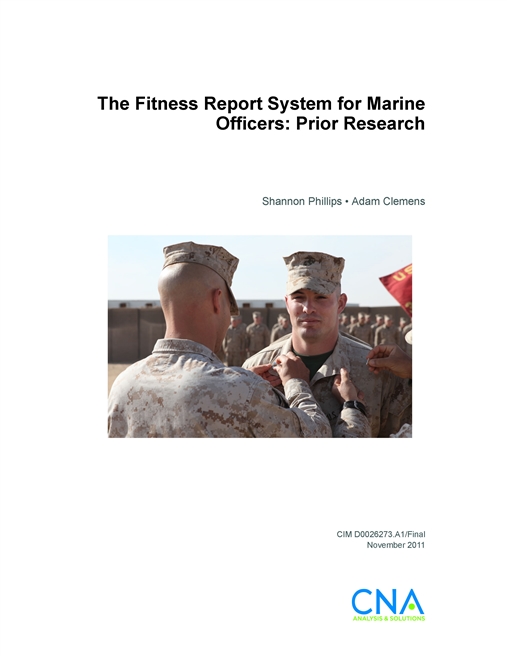The Marine Corps Fitness Report (FitRep) system provides the official evaluation and record of an officer’s performance. Given the FitRep’s importance in determining fair and equal opportunity for career progression and continuation, it is crucial that the system be reviewed periodically. The Marine Corps implemented the current FitRep system in 1999 to address concerns about grade inflation, and the system has not received a thorough examination since then.
The Director, Manpower Management Division asked CNA to conduct a systematic review of the FitRep system for officers and to examine whether the system is accomplishing what the Marine Corps intended. This is a broad question that encompasses several issues. Previous studies have focused on two issues:
- How do FitRep marks differ by observable characteristics?
- How do FitRep marks affect promotion and continuation?
This information memorandum reviews the literature on the Marine Corps FitRep system to inform our analysis of these two questions, and it notes the literature’s relevance to our broader research agenda. Review highlights include the following:
- Estimates suggest that inflation of FitRep scores was a problem among company-grade officers and majors from FY99 to FY04, with scores increasing by 2 to 5 percent.
- Studies consistently found that black Marines—both enlisted and officers—received lower FitRep marks than white Marines. The only possible evidence of bias found was that black staff ser- geants received lower FitRep marks from white reporting seniors (RSs) than from black RSs in the early 1980s.
- There is broad consensus in the literature that, among both enlisted personnel and officers, female Marines and married Marines have higher FitRep scores.
- Earlier research has found that officers commissioned at a younger age had higher marks, controlling for commissioning source.
- A consistent finding in the literature is that officers accessed through the United States Naval Academy (USNA) or enlisted- to-officer (E-to-O) programs had higher FitRep marks.
- Previous analyses show that officers with a higher class standing at The Basic School (TBS) received higher FitRep marks.
- Recent research suggests that officers in finance and legal occu- pations scored higher on FitReps than those in infantry and logistics, while officers in communications and artillery occupations received the lowest FitRep marks.
- The literature consistently indicates that RS marks are a positive predictor of promotion to major and lieutenant colonel.
- Studies report that reviewing officer (RO) marks are positive predictors of promotion to lieutenant colonel and colonel, but not to major.
The correlation of FitRep marks with observed quality indicators, such as class standing and prior military experience, is both unsur- prising and encouraging. Systematic differences across occupations or between black and white officers are potential causes for concern that merit further study.
Download reportApproved for Public Release Distribution Unlimited. Specific authority: N00014-11-D-0323
Details
- Pages: 40
- Document Number: CIM D0026273.A1/Final
- Publication Date: 11/1/2011
